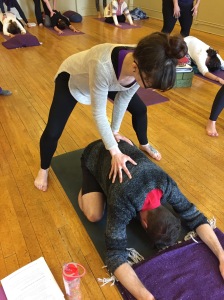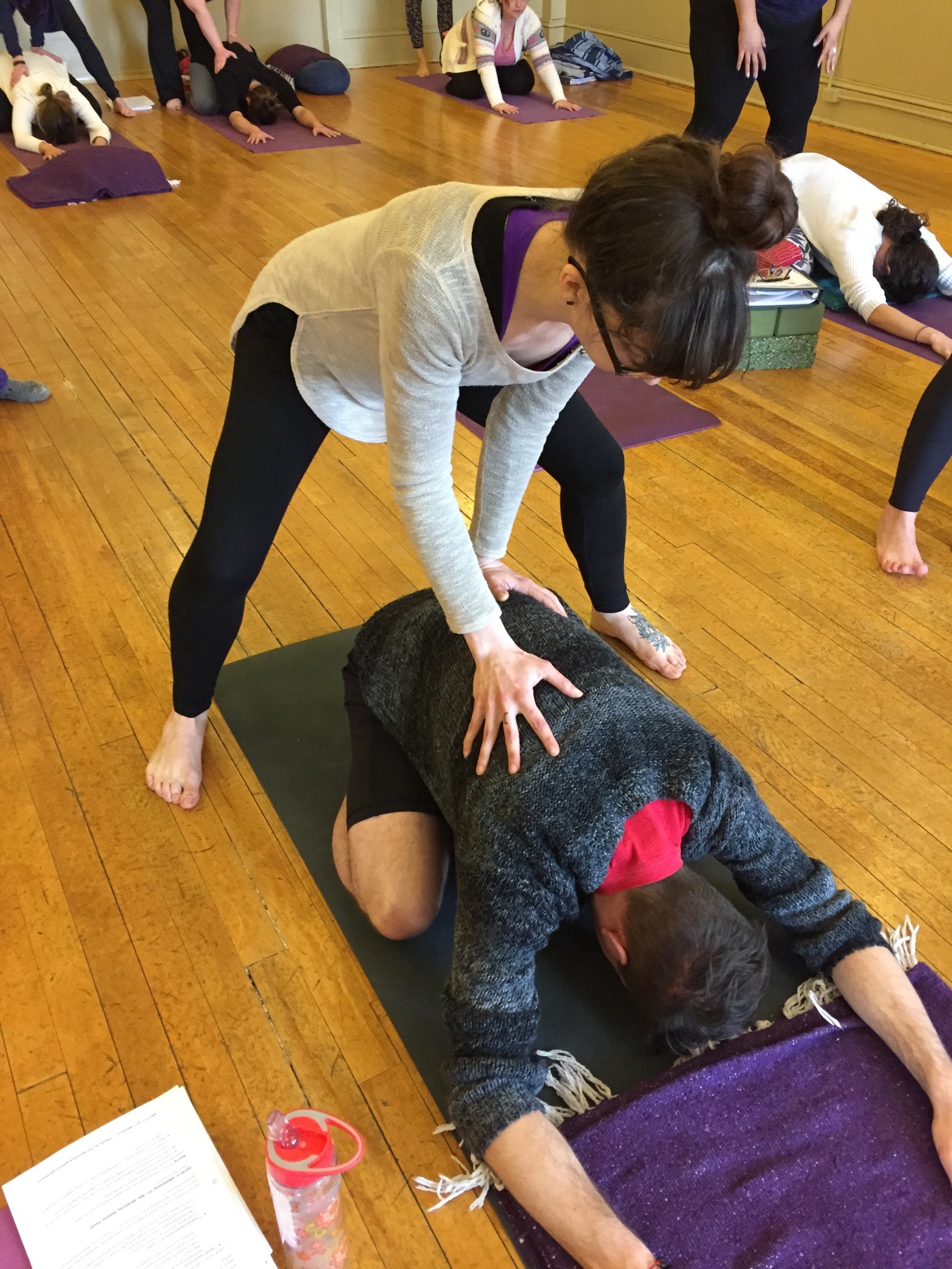 “My adjustment card is always turned to green but I rarely get hands-on adjustments from the teacher. I am starting to take it kind of personally. Why aren’t I getting more hands-on adjustments?”
“My adjustment card is always turned to green but I rarely get hands-on adjustments from the teacher. I am starting to take it kind of personally. Why aren’t I getting more hands-on adjustments?”
Queen Street Yoga had this question posed to us by a student and we want to respond to it. There is a big conversation about hands-on adjustments going on in the yoga community that includes conversation about teaching styles and qualifications, consent, and trauma awareness. Emma is one of the Co-Directors of Queen Street Yoga, and this is her current thinking/reflecting around common assumptions about hands-on adjustments. We welcome your comments, feedback, and conversation around this topic.
Assumption #1 – Yoga teachers are fully qualified and trained to give manual/therapeutic* adjustments.
*Manual means “with the hands” and therapeutic means “related to healing.” Example: a chiropractor might give a therapeutic adjustment to someone to help relieve pain or heal an injury.
Emma’s experience: Manual/therapeutic* adjustments were included in my original teacher training eight years ago, but I don’t give many of those adjustments anymore because I don’t feel qualified enough to give them. When I was a new teacher I used to give the adjustments that I learned in my first teacher training to many of my students, and now I am questioning that decision. Some teacher training programs focus more on hands-on adjustments, but I think that this is an advanced teaching skill, and one that requires dedicated thought, mentorship, and specific training.
I also think that when teachers create a culture of giving a lot of hands-on adjustments, this can create a power dynamic between teachers and students, and even contribute to students feeling left out (if the teacher doesn’t touch them) or singled out (if the teacher touches them a lot). In my classes, I would like students to be focused on their own relationship with their body, not thinking about their relationship to me. I am consciously working to question and challenge these kinds of subtle power dynamics, not just in how they show up in my life as a teacher, but in all of my relationships and interactions.
The other concern I have about hands-on adjustments is around consent. I have been to classes at studios where it seemed like the teacher was going around and giving massage-like touch to all the students. This was at a studio where they did not have adjustment cards, so I was not able to opt out of being touched if I wished. I am concerned not just about the amount of training that a yoga teacher has in giving hands-on adjustments, but also about the way that they interact with students, and whether teachers have clearly obtained a student’s consent to touch them. These days I am trying to come from a trauma-aware place: that I can’t know someone’s background by looking at them, and that there is no way for me to ascertain whether touching them is going to feel appropriate for them. Even if I verbally ask, there is still the possibility that people will feel some kind of pressure to say “yes” to my offer of touch. This is why we have adjustment cards at Queen Street Yoga, in the hopes of growing a culture where it is easier to clearly say “no” with the simple placement of a card. And, more may still be needed to truly create a culture of clear consent.
Assumption #2 – Manual adjustments are necessary for students to learn correct positioning/actions in yoga.
Emma’s experience: I think that manual adjustments can be helpful for some students in some instances, but I notice most of my students learn better through seeing a demonstration, hearing different verbal explanations or the use of imagery, and learning slowly over time.
I used to give more hands-on adjustments, but when I did, I noticed that students would often have a hard time replicating the adjustment/position when they did the pose again on their own. It seemed to me that hands-on adjustments were not as effective a teaching method as I had expected, or as I had been told. The adjustment would temporarily yield a change in the student’s positioning in the pose, but not a long-term change in the student’s ability to do it by themselves.
I have changed my teaching in the last few years to include more visual demonstrations (showing something in my own body) and more verbal explanations (explaining why a certain position might be more structurally supportive or helpful to them). I notice that when students learn to adjust/re-position themselves, they are often more able to apply that understanding to similar poses and to their practice as a whole.
There are some instances when a hands-on adjustment can make a huge difference to a student (when the verbal explanations are not making sense to them, or their body is so different from the instructor that a visual example isn’t helpful). I try to keep my eyes open for these instances. I also want to welcome students at Queen Street Yoga to let their teachers know if they feel that hands-on adjustments would be especially helpful to their way of learning.
Thanks for reading! We welcome your comments, feedback, and conversation around this topic.
 Emma Dines is the creative director of Queen Street Yoga. She loves writing, visiting thrift stores, and going for walks in the woods. She also loves cartwheeling, sewing, and making her own kimchi.
Emma Dines is the creative director of Queen Street Yoga. She loves writing, visiting thrift stores, and going for walks in the woods. She also loves cartwheeling, sewing, and making her own kimchi.


I think what is forgotten in this very important….benefit of manual adjustment and value of it…. people like me are unaware what needs to be corrected or there is no connection or path between brain and certain mussels in body… how to engage them or teacher verbal instructions can’t be translated by brain into centennial part of body…. I remember times when manual adjustments in queen street yoga were very common…. among students under guidance of teacher or by teacher…. simple things like push had into someone head to wake up mussel or awearness of body. I miss it and think it was very valuable. Or placing hands on part of back or leg or feet or tie that needs to be puffed up…this is particularly true from my experience and very helpful in inversions. With no touch teachings I think journey to wake up parts of body is longer and harder. Isnt this all sbout mussel memory…and how to build mussel memory if brain can not process verbal info…I belive teachers should be qvolified to do this….particularly for beginner stages…. I think that asanas should be done as close as possible what are they originated to be within body limitation. I remember few aha moments when adjusted manually after years of practicing….verbal instructions from diferent teachers and diferent instructions on same issue simply did not do it… I think not only in yoga but in all plains of life and society if we take approach it’s good enough or who careas how pose look like we are loosing core of original values…. and questioning value of it…..if anything is good and anything goes we will start driving on wrong side of road…what brings safety and potential injuries on poses if not corected…this just my experience with this subject what brings in mind question…. why would someone come to class if does not want to be adjusted…. there are yoga clases on Web promoted by qsy….and certenlly good quality Clases? Self estime and self judgments are big part of this journey…are we forgetting that yoga is non judgmental….?…. wow this is long…